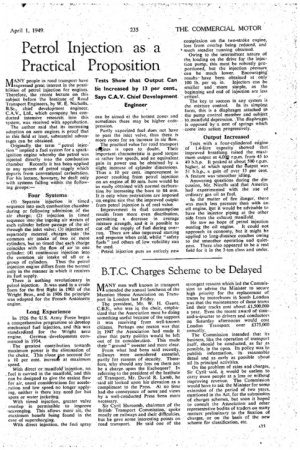Petrol Injection as a Practical Proposition
Page 25

If you've noticed an error in this article please click here to report it so we can fix it.
Tests Show that Output Can be Increased by 13 per cent., Says C.A.V. Chief Development Engineer peeTANY people in road transport have IVIexpressed great interest in the possibilities of petrol injection for engines. Therefore, the recent lecture on this subject before the Institute of Road Transport Engineers, by W. E. Nicholls.
• B.Sc., chief development engineer, CA.V., Ltd., which company has conducted intensive research into this system, was received with approbation.
The author said that its increasing adoption on aero engines is proof that in this field at least, substantial advantages can be obtained.
Originally Ole term "petrol injec, lion" implied a fuel system for a sparkignition engine whereby the petrol was injected directly into the combustion chamber Recently it has been applied to any system of petrol sUpply which departs from conventional carbuitition. For his lecture, howeyee, he dealt only with systems falling within the follow
ing groups:— Four Systems (1) Separate injection in timed sequence into each combustion chamber during or following admission of the air charge; (2) injection in timed . sequence intojhe ingoing air stream of each cylinder before passage of the air through the inlet valve; (3) injection of separately metered charges into 'the common air intake of two or more cylinders, but so timed that each charge coincides with the flow, of air to one cylinder; (4) continuous injection into the common air intake of all or a
group of cylinders. Thus the petrol injection engine differs from the Parmat only in the manner in which it receives its fuel supply.
There is nothing revolutionary in petrol injection. It was used in a crude form for the first flight in 1903 of the Wright Bros., and in 1906 the principle was adopted for the French Antoinette engine.
Long Experience
In 1926 the U.S. Army Farce began a comprehensive programme to develop mechanical fuel injection, and this was standardized for the Wright aero
engine. German ,developments commenced in 1934.
The greatest contribution towards maximum power is the elimination of the choke. This alone an account for a 10 per cent. inerea* at maximum speed.
With direct or manifold-injection, no fuel is carried in the manifold, and this can be designed to give the easiest flow for air, usual considerations for aecele. ration and low speed no longer applying, neither is there -any need for hot spots or water jacketing.
With timed injection, greater valve overlap is permissible to improve -scavenging. This allows more air, the maximum benefit being found in the Case of supercharging.
With direct injection, the fuel spray
can be aimed, at the hottest zones and sometimes there may be higher compression.
Partly vaporized fuel does not have to pass the inlet valve, thus there is more room for an increase in air flow.
The practical value for road transport eilltines is open to doubt. Their important characteristic is good torque at rather low speeds, and an equivalent gain in power can be obtained by a slight increase of cylinder dimensions. Thus a 10 per cent. improvement in power resulting from petrol injection on an engine of 80 mm. bore would be as easily obtained with normal carburation by increasing the bore to 84 mm. It is only when restrictions are imposed on engine size that the improved out* from petrol injection is of real value.
Improvement in fuel consumption results from more even distribution, permitting a decrease in average mixture strength, and it is possible to cut-off the supply of fuel during overrun. There are also -improved starting and response when cold, whilst "safety fuels" and others of low volatility can be used.
Petrol injection puts an entirely, new complexion on the two-stroke engine, loss from overlap being reduced, and much steadier running obtained.
Owing to the intermittent nature of the loading on the drive for the injection pump, this must be robustly proportioned, but the injection pressure can be much lower, Encouraging' resultshave been obtained at only 100 lb. per sq. in. Injectors can be smaller and more simple, as the beginning and end of injection are less The key to success in any system is the mixture control. In its simplest form, this is a diaphragm attached to the pump control member and subject to manifold depression. .The diaphragm is opposed by a nest of springs which come into action progressively.
Output Increased Tests with a four-cylindered engine of 1.4-litre capacity showed that improved breathing raised the maximum output at 4,00D r.p.m. from 45 to 49 b.h.p. It peaked at about 500 rpm', higher, at which speed the t utput was 51 b.h.p., a gain of over 13 per cent. A feature was ,smoother Answering questions during the dis,cussion, Mr. Nicolls said that America had experimented with the use of ordinary gas oil as fuel.
In the matter of fire danger, there was much less pressure than with an oil engine, 1/tit it would be advisable to have the injector piping at the other side from the exhaust rnanifold.
He saw no hope Of petrol injection ousting the oil engine. It could not approach its economy, but it might be applied to long-distance coaches owing to the smoother operation and quietness. There also appeared to be a real field for it in the 3-ton class and uncle'.


























